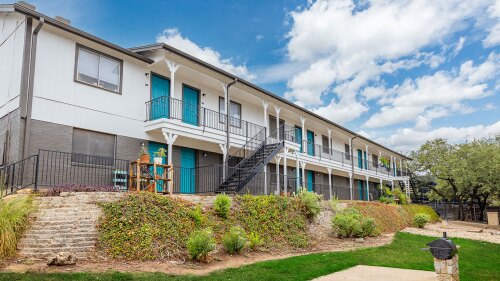What will happen when a large share of the $1.3 trillion in commercial mortgage loans made from 2000 through 2007 comes due in the next few years?
In the next 18 to 36 months, thousands of mortgage loans made on U.S. commercial properties from 2000 through 2007 will come due, but many of those property owners will be unable to pay them off or roll them over. This is almost certain because the market values of those properties have fallen from 25 to 40 percent since the loans were made. Moreover, banks are no longer willing to make loans at loan-to-value ratios of more than about 65 percent—much lower than the 70 to 90 percent ratios they used from 2000 to 2007. So owners will be asked to come up with a lot more equity capital to cover their loans, but where will they get that capital? Traditionally, they would borrow it from banks, but most banks will not lend to them under such circumstances. The only way for the nation to avoid massive commercial property foreclosures and losses in asset values would be for other investors to put up capital to cover the resulting equity gaps.
Unfortunately, many potential private investors of capital are demanding high potential yields on any capital they supply. They want yields comparable to those they were obtaining—or trying unsuccessfully to obtain—in 2007. At an annual real estate conference held in Chicago in June, many of the 150 potential investors and owners of all types of properties stated they were waiting for the return of yields as favorable as those in 2007 before they would put up much new equity capital.
But the high yields such investors obtained in 2007—at least on paper—cannot be replicated today or in the near future. Why not? Because real estate markets from 2000 through 2007 were based on two completely unsustainable conditions—as proved by the subsequent collapse in both housing and commercial property values in 2008 to 2009.
The first unsustainable condition—experienced mainly in residential lending, but eventually affecting commercial lending, too—was huge overleveraging by commercial banks, investment banks, and other capital suppliers. They were almost all making residential mortgage loans, pooling them into mortgage bonds, and selling those bonds around the world. They then used the proceeds to carry out another round of the same steps—all supported only by the same reserves used to cover the first group of loans they originated. This process resulted in leverage ratios of up to $30 in loans made for every $1 in reserves, rather than the traditional $10-to-$1 ratio. But as recent experience proves, that level of reserves is not enough to cope with enormous default problems like those that occurred after 2007.
The second unsustainable condition was widespread incompetence and fraud—also mainly in housing markets. Those gross errors were committed by mortgage bankers, brokers, and originators creating very risky subprime loans; commercial banks and investment banks securitizing those loans; private credit rating agencies giving AAA ratings to many poor-quality mortgage bond issues; and homebuilders vastly overbuilding their markets. Those groups were motivated by greed to use practices that were either illegal (such as lending more than the total current value of properties); stupid (such as making loans without verifying borrower incomes, building more new homes than markets could absorb, and speculating on ever-rising home prices); or bound to fail (such as issuing high residential mortgage bond ratings without carefully investigating the properties involved). All these actions sidestepped or ignored common sense, best practices, and legal regulations.
The results were large-scale defaults by subprime homebuyers that soon spread mortgage bond failures across the globe. Those defaults caused a global loss of confidence in all U.S. mortgage-backed securities, both residential and commercial. That loss of confidence, in turn, gravely weakened investor willingness to buy all types of U.S. securities. The resulting financial paralysis led to a worldwide collapse in prices and transactions in both residential and commercial property markets in 2008 and 2009. In addition, in July 2010, the U.S. Congress passed stricter new government regulations affecting all real estate finance. These outcomes make it unlikely that any of those unsustainable practices will be available in the future—or at least not for many years.
The resulting changes in property market conditions—especially the sharp decline in the leverage ratios banks and other investors can use—will prevent nearly all real estate investors from achieving yields of 17 to 30 percent on their equity investments. Moreover, firms that raise funds to invest in real estate cannot realistically promise their investors such high yields. Yet from 2000 through 2007, in commercial property loan markets for investments in opportunity funds and other high-risk funds, such relatively high yields had always been promised, and often achieved.
The National Council of Real Estate Investment Fiduciaries (NCREIF) average annual yield from 1978 through 2009 was 9.1 percent. In the three peak years—2005, 2006, and 2007—the average NCREIF yield was 17.5 percent. But NCREIF properties are mainly core real estate rather than higher-risk investments like those pursued by opportunity funds, private equity funds, and other more venturesome investment operators. Moreover, NCREIF’s reported yields are calculated as though all the properties in the index are unleveraged, even though many actually are. But almost all opportunity and other high-risk funds compute their returns using significant leverage with debt. Like those investors who put cash into those funds then, many analogous investors today are still seeking yields of 17 to 30 percent.
Unfortunately for them—and for the availability of equity capital for property owners—that is an extremely unlikely target to aim for under present market conditions and new financial regulations. Market conditions in commercial properties are still very unfavorable. The average office vacancy rate is over 17 percent, rents are still falling, and many former occupants of office space have gone out of business. Apartment vacancies also are high, and retailers are suffering from losses of buyers because of high general unemployment. Hotel occupancy levels and room rates have improved since the crash days of early 2009, but are still nowhere near their levels before 9/11 or 2005.
For all these reasons, owners of commercial properties are neither capable of paying nor willing to pay the high yields that many potential investors with cash are demanding in order to put up more equity capital. The property owners cannot see any near-term prosperity that would justify paying higher yields to get more equity. And many potential investors are as yet unwilling to abandon their high earnings expectations.
The result is that many holders of commercial property loans made from 2000 through 2007 will not be able to pay on time when their loans come due in the next few years. Borrowers will simply be unable to raise enough additional equity capital to make such payments. The likely magnitude of potential defaults is huge. In the eight years from 2000 through 2007, commercial mortgage borrowing totaled $1.288 trillion—8.4 times as much as the $154.2 billion of commercial mortgages borrowed in the eight preceding years, 1992 through 1999, according to Federal Reserve Flow of Funds data. These data show the enormous amount of commercial mortgage lending from 2000 through 2007 made possible by the two unsustainable conditions described above. Now that those conditions have been erased—we hope—the total amount of commercial mortgage lending that the banking system can carry out in the next eight years will necessarily be much smaller than the amount it originated from 2000 through 2007. That will be the consequence of the deleveraging the entire banking system must go through in the near future, compared with its excessively leveraged performance in the early 2000s.
What will happen when a large share of the $1.288 trillion in commercial mortgage loans made from 2000 through 2007 comes due in the next few years? The banking system itself will be unable to refinance those loans by supplying the equity needed to close the equity gap between its original loans and the equity needed to pay off or roll over those loans. Deleveraging in general will make that impossible. And bankers will not repeat the favorable lending terms they offered from 2000 through 2007. So where will the added equity needed come from?
Many observers believe there is a lot of financial capital being held out of all investment markets for two reasons—uncertainty about how rapidly the U.S. economy will recover, and unwillingness by the owners of such capital to accept any yields lower than those they enjoyed in the early 2000s. The Federal Reserve Board reported that U.S. nonfinancial companies were sitting on $1.84 trillion in cash and other liquid assets at the end of March 2010, up 26 percent from one year earlier. But many holders of such cash are waiting until they believe they can obtain higher yields. This seems almost impossible under present economic conditions and within the laws for financial activities that Congress just passed.
That leaves five potential sources of equity for commercial loans coming due:
- publicly held real estate investment trusts (REITs);
- private opportunity and vulture funds, and private equity funds;
- commercial banks and other lenders who extend their loans coming due far enough into the future so that more active bank lending may be available by the time the loans become due again;
- mortgage servicing firms assigned to cope with overdue commercial loans; and
- commercial banks and other lenders who take back the properties concerned and absorb the equity losses themselves.
The first potential source, REITs, have recently been able to raise a lot of equity capital by floating secondary stock offerings and unsecured debt in public security markets. From 2002 through 2007, before the stock market crash of 2008 to 2009, they raised $207.3 billion, about one fourth in common stock and one half in unsecured debt, according to the National Association of Real Estate Investment Trusts (NAREIT). In 2008, their capital raising fell by half, but it recovered in 2009 to $34.7 billion, and in the first half of 2010 to $22.0 billion. Also, most REITs are only leveraged with debt by 50 to 60 percent or less, so they are not very susceptible to bankruptcy—a key reason they have been able to raise more capital.
REITs have been raising large amounts of capital in public markets, but up until now they have used it mainly to deleverage their balance sheets. But REITs could use such capital to buy many of the properties with debts coming due in the next few years. Investors who have been putting capital in REITs would thus make it possible for lenders with their loans coming due to recoup some of their possible loan losses by selling the properties concerned to REITs, or persuading their borrowers to do so. Given the recent ability of REITs to raise funds in capital markets, this seems the most likely way to put large amounts of equity into paying off the debts that the present debtors cannot pay. In many cases, this would require banks and other lenders to take back the properties concerned and then sell them to REITs, possibly at prices far below the original values of those properties—but at prices high enough that REITs would get lower yields than in the past.
Lower yields on commercial properties also are being made more likely by banks changing their lending practices. They now focus entirely on current cash flows, not imputed property values or potential future cash flows. That shift has even rendered the apparent cost of land—at least in the eyes of banks and other lenders—to zero if any land included in a deal throws off no current cash flows. This is one reason why it is realistic for both existing and potential commercial property owners to expect lower yields on their properties than in the boom period of the early 2000s.
The second possible source of capital to deal with such loans is private opportunity and vulture funds, and private equity funds. Most such firms have no interest in holding the properties concerned for long periods; rather, they want to sell them at a profit within one to a few years. These firms could buy the potentially delinquent properties from their current owners at distressed prices in the hope of improving cash flows and then selling those properties at a profit. Or they could simply resell the properties at slightly higher prices than they paid for them without improving cash flows. However, this group has to raise money for its activities by getting other investors to put up cash. In the past, these funds have raised a lot of money by promising investors very high yields, in the 17 to 30 percent range—extremely unlikely in today’s economic and political climate.
Some funds that concentrate mainly on core properties may be able to attract funds with promises of lower yields than those they promised in the past. But to be realistic, it is unlikely that more aggressive opportunity and private equity funds —which traditionally promised very high yields—will be able to attract enough capital from their own investors. This possible source probably will not be enough to provide a large amount of the missing equity necessary to cope with all the commercial debts soon coming due, especially with such properties throwing off lower yields than in the past.
The third possible source of capital to cope with commercial loans coming due consists of the lenders themselves, whether they are banks or other lenders. Lenders could simply extend their loans outward for several years in the hope that economic conditions will improve in the meantime. Then, either banks would resume lending funds to the borrowers involved, or a strongly recovering economy would enable the borrowers to make enough more money to pay off or roll over their loans without added equity. That is what many banks and other lenders have been doing up until now.
For two reasons, those lenders have not wanted to take over the properties concerned: if they did so, they would be forced to show large losses on their books, plus they would have to manage the properties themselves, something they are not likely to do well.
However, such loan extensions do not solve the problem of obtaining enough equity to cover all commercial mortgages coming due; they just defer that problem to the future. Yet many banks and other lenders may continue granting extensions in order to avoid both absorbing writedowns on their now-overdue loans and managing the properties concerned. Such extensions are especially likely if the lenders are, in effect, capturing almost all the cash flows from such properties without having either to own them or run them.
The fourth possible approach is for special servicing firms that are trying to cope with delinquent mortgage borrowers to work out some form of settlement that satisfies both the lenders and the borrowers. But this seems unlikely in many cases of major commercial delinquency for three reasons. First, and most decisive, is that special servicers have no ready access to sources of capital. Second, there is a huge gap between what the borrowers owe and their ability to pay. Third, the complexity of creating such deals requires lengthy negotiations among three parties—borrowers, servicers, and lenders. Up to now, this time-consuming method has succeeded in remedying very few delinquent commercial loans.
The last approach does not really solve the problem of the equity gap; rather, it involves lenders swallowing the gap. In this approach, banks and other lenders foreclose immediately when their loans come due, and take ownership of the properties concerned. This compels them to write down the original values of the loans on their books, which may often be larger than the then-current market values of the properties they thus assume. The foreclosing parties then must either manage their new properties or try to sell them at a loss compared with the original book values of the property loans. As noted, the market values of most commercial properties fell by 25 to 40 percent in the great value crash of 2008 to 2009. The desire to avoid this outcome is why so many banks and other lenders are granting long extensions to commercial borrowers when their loans come due.
Which of these five approaches is most likely to fill the equity gap? In my opinion, it is the REIT approach. REITs seem capable of raising a lot of additional equity and other capital through public securities markets or unsecured loans. Then investors with money to put out can buy shares or bonds of the REITs that purchase such delinquent properties.
The second approach, built on opportunity or private equity funds, will not be able to produce the high yields such funds have traditionally promised their investors. Hence—except for some core investment funds—they will find it harder to raise funds than in the boom years of the early 2000s. The third approach, extending loans well into the future, merely defers the equity gap problem in the hope that borrowers will by then be able to raise more capital. The fourth approach, relying on special service firms to craft successful deals, probably cannot achieve enough volume to cope with the problem. The fifth approach, having banks and other lenders foreclose immediately and take ownership of delinquent properties also fails to solve the equity gap. Instead it forces lenders to absorb losses when the borrowers cannot pay the loan payments due.
How accurate my predictions are can only be resolved by the passage of time. But one thing is clear: there will be a lot of turmoil in commercial real property markets over at least the next few years.




